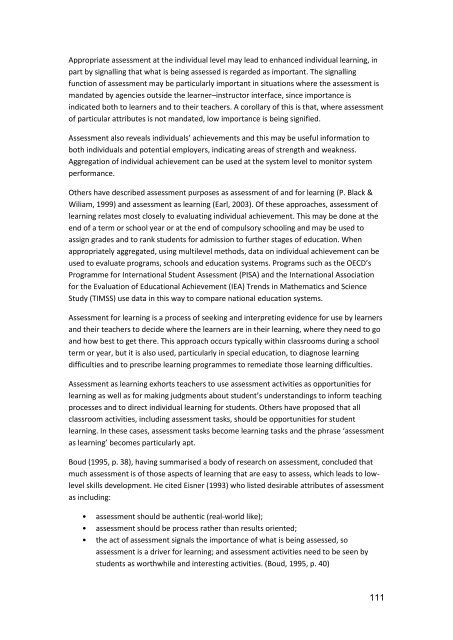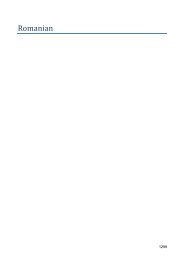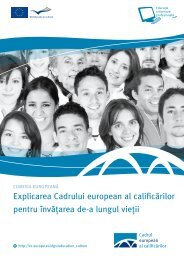Teaching and Assessing Soft Skills - MASS - Measuring and ...
Teaching and Assessing Soft Skills - MASS - Measuring and ...
Teaching and Assessing Soft Skills - MASS - Measuring and ...
You also want an ePaper? Increase the reach of your titles
YUMPU automatically turns print PDFs into web optimized ePapers that Google loves.
Appropriate assessment at the individual level may lead to enhanced individual learning, in<br />
part by signalling that what is being assessed is regarded as important. The signalling<br />
function of assessment may be particularly important in situations where the assessment is<br />
m<strong>and</strong>ated by agencies outside the learner–instructor interface, since importance is<br />
indicated both to learners <strong>and</strong> to their teachers. A corollary of this is that, where assessment<br />
of particular attributes is not m<strong>and</strong>ated, low importance is being signified.<br />
Assessment also reveals individuals’ achievements <strong>and</strong> this may be useful information to<br />
both individuals <strong>and</strong> potential employers, indicating areas of strength <strong>and</strong> weakness.<br />
Aggregation of individual achievement can be used at the system level to monitor system<br />
performance.<br />
Others have described assessment purposes as assessment of <strong>and</strong> for learning (P. Black &<br />
Wiliam, 1999) <strong>and</strong> assessment as learning (Earl, 2003). Of these approaches, assessment of<br />
learning relates most closely to evaluating individual achievement. This may be done at the<br />
end of a term or school year or at the end of compulsory schooling <strong>and</strong> may be used to<br />
assign grades <strong>and</strong> to rank students for admission to further stages of education. When<br />
appropriately aggregated, using multilevel methods, data on individual achievement can be<br />
used to evaluate programs, schools <strong>and</strong> education systems. Programs such as the OECD’s<br />
Programme for International Student Assessment (PISA) <strong>and</strong> the International Association<br />
for the Evaluation of Educational Achievement (IEA) Trends in Mathematics <strong>and</strong> Science<br />
Study (TIMSS) use data in this way to compare national education systems.<br />
Assessment for learning is a process of seeking <strong>and</strong> interpreting evidence for use by learners<br />
<strong>and</strong> their teachers to decide where the learners are in their learning, where they need to go<br />
<strong>and</strong> how best to get there. This approach occurs typically within classrooms during a school<br />
term or year, but it is also used, particularly in special education, to diagnose learning<br />
difficulties <strong>and</strong> to prescribe learning programmes to remediate those learning difficulties.<br />
Assessment as learning exhorts teachers to use assessment activities as opportunities for<br />
learning as well as for making judgments about student’s underst<strong>and</strong>ings to inform teaching<br />
processes <strong>and</strong> to direct individual learning for students. Others have proposed that all<br />
classroom activities, including assessment tasks, should be opportunities for student<br />
learning. In these cases, assessment tasks become learning tasks <strong>and</strong> the phrase ‘assessment<br />
as learning’ becomes particularly apt.<br />
Boud (1995, p. 38), having summarised a body of research on assessment, concluded that<br />
much assessment is of those aspects of learning that are easy to assess, which leads to lowlevel<br />
skills development. He cited Eisner (1993) who listed desirable attributes of assessment<br />
as including:<br />
• assessment should be authentic (real-world like);<br />
• assessment should be process rather than results oriented;<br />
• the act of assessment signals the importance of what is being assessed, so<br />
assessment is a driver for learning; <strong>and</strong> assessment activities need to be seen by<br />
students as worthwhile <strong>and</strong> interesting activities. (Boud, 1995, p. 40)<br />
111





